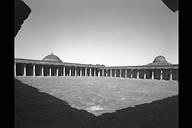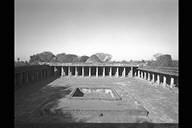
→Detailed Explanation
→List of photos
the southwest.
Left;north gate Right;east gate
DHAR
It used to be the capital of Malwa region under the Paramara Dynasty. After the conquest by Ala ad-Din (1296-1316) of the Khalji Dynasty in Delhi, Islam power spread to Dhar. The Daragiri fort which was reconstructed in 1344 by Muhammad bin Tughluq is situated about 3 km from the town center. In 1387, Dilawar Khan Ghori was appointed as the ruler but he named himself sultan in 1400 and moved the capital to Mandu. The current Dhar extends its new town centre on the east side. At the centre of Dhar, Kamal Maula Masjid, and at the south east end, Lat-ki Masjid remains. Both were converted from the architecture of the Paramara Dynasty. (Naoko Fukami)
1.LAT -KI MASJID (1404)
2.KAMAL MAULA MASJID (The first half of 15th C.)
 |
Its common name
"lat" is said to come from either
"lat" (old) or "lath" (Pillar). It is
called "Lat Masjid" as well. With the former
word, it can mean "old mosque", and with the
latter it may mean "mosque with pillars", as
multiple pillars are significant in the west prayer room
and in corridors. However, in general, it is a more
convincing theory that the name comes from a monument for
victory that Raja Bhoja of the Paramara Dynasty built
nearby. (Matsuo Ara) →Detailed Explanation →List of photos |
| ▲Viewing the courtyard from the southwest. Left;north gate Right;east gate |
|
 |
This mosque was
very similar to Dilawar Khan and Malik Mughith of Mandu.
Both these mosque and Lat-ki Masjid seem to have been
built in the early 15th century. They have similarity in
structure and style. Also, there are similarities with a
mosque from the Sultanate period remaining in Delhi. The
common name of this mosque "Kamal Maula" seems
to come from a tomb of a Muslim saint Maulanah Kamal
al-Din. (Matsuo Ara) →Detailed Explanation →List of photos |
| ▲Viewing the prayer
room from the east. |
|